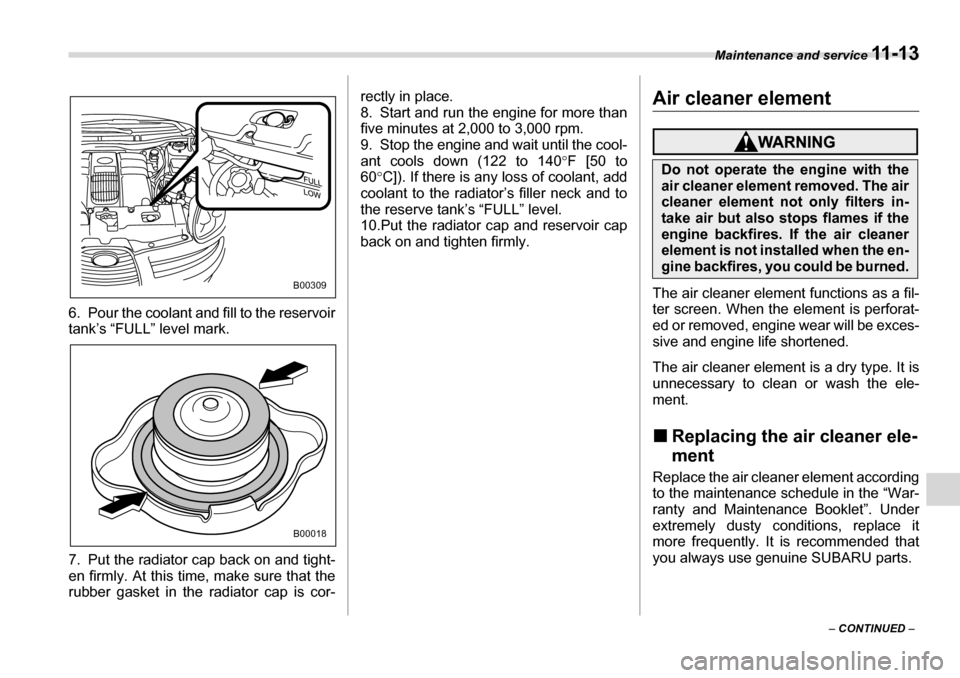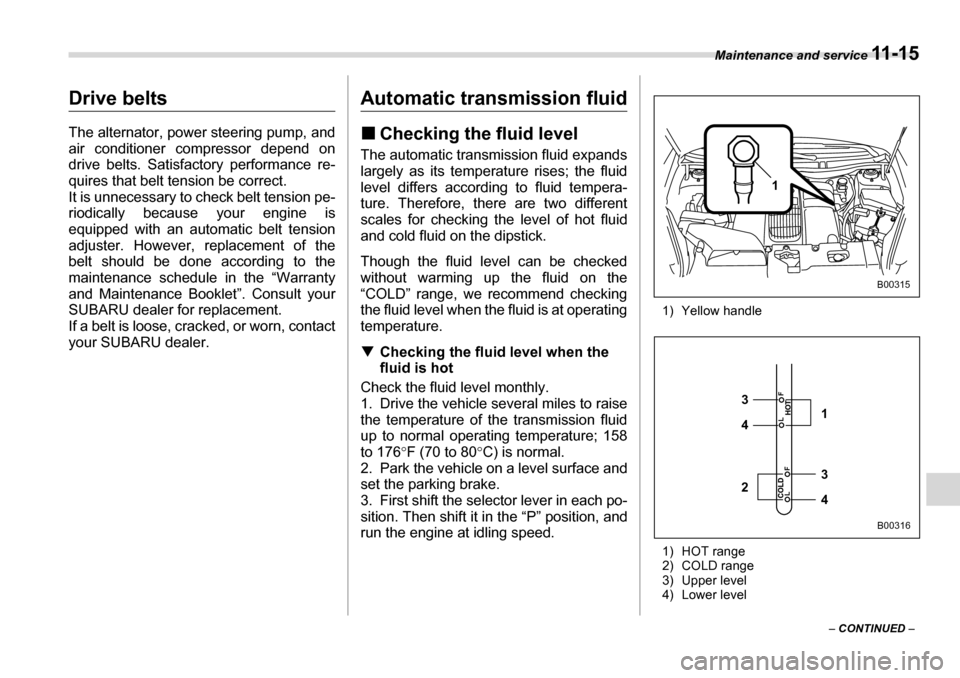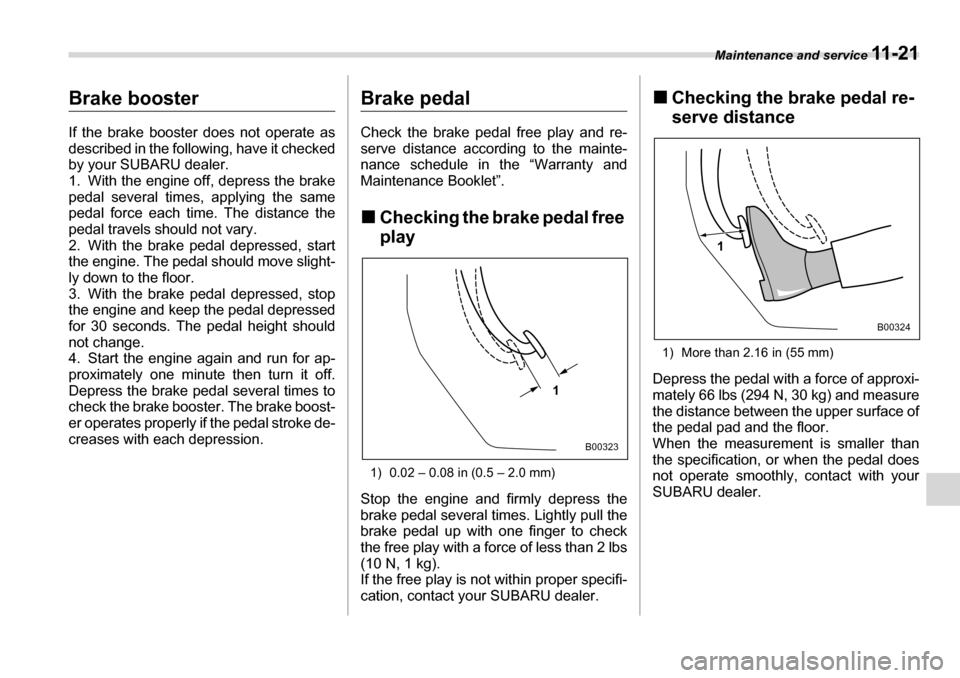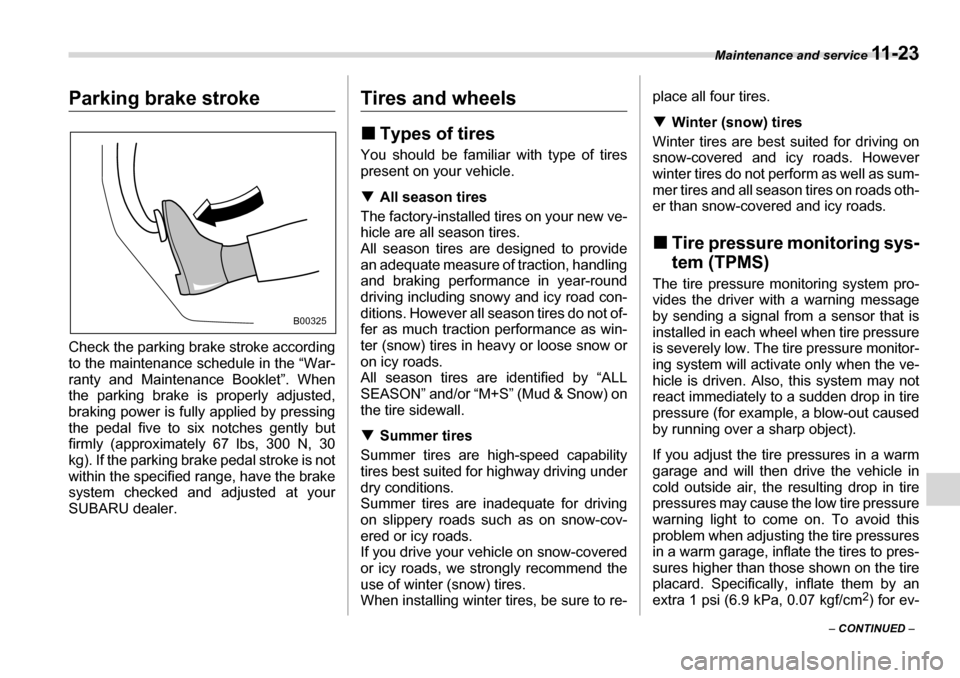2006 SUBARU TRIBECA maintenance schedule
[x] Cancel search: maintenance schedulePage 310 of 377

Maintenance and service 11 - 1 3
– CONTINUED –
6. Pour the coolant and fill to the reservoir
tank’s “FULL” level mark.
7. Put the radiator cap back on and tight-
en firmly. At this time, make sure that the
rubber gasket in the radiator cap is cor- rectly in place.
8. Start and run the engine for more than
five minutes at 2,000 to 3,000 rpm.
9. Stop the engine and wait until the cool-
ant cools down (122 to 140
°F [50 to
60 °C]). If there is any loss of coolant, add
coolant to the radiator’s filler neck and to
the reserve tank’s “FULL” level.
10.Put the radiator cap and reservoir cap
back on and tighten firmly.
Air cleaner element
The air cleaner element functions as a fil-
ter screen. When the element is perforat-
ed or removed, engine wear will be exces-
sive and engine life shortened.
The air cleaner element is a dry type. It is
unnecessary to clean or wash the ele- ment. �„ Replacing the air cleaner ele- ment
Replace the air cleaner element according
to the maintenance schedule in the “War-
ranty and Maintenance Booklet”. Under
extremely dusty conditions, replace it
more frequently. It is recommended that
you always use genuine SUBARU parts.B00309
B00018
Do not operate the engine with the
air cleaner element removed. The air
cleaner element not only filters in-
take air but also stops flames if the
engine backfires. If the air cleaner
element is not installed when the en-
gine backfires, you could be burned.
Page 311 of 377

11 - 1 4 Maintenance and service
1. Unsnap the two clamps holding the air cleaner case cover.
2. Open the air cleaner case cover and
remove the air cleaner element.
3. Install a new air cleaner element. 4. To install the air cleaner case cover,
snap the two clamps on the air cleaner case cover.
Spark plugs
It may be difficult to replace the spark
plugs. It is recommended that you have
the spark plugs replaced by your
SUBARU dealer.
The spark plugs should be replaced ac-
cording to the maintenance schedule in
the “Warranty and Maintenance Booklet”. �„
Recommended spark plugs
ILFR6B (NGK)
B00312
B00313
Page 312 of 377

Maintenance and service 11 - 1 5
– CONTINUED –
Drive belts
The alternator, power steering pump, and
air conditioner compressor depend on
drive belts. Satisfactory performance re-
quires that belt tension be correct.
It is unnecessary to check belt tension pe-
riodically because your engine is
equipped with an automatic belt tension
adjuster. However, replacement of the
belt should be done according to the
maintenance schedule in the “Warranty
and Maintenance Booklet”. Consult your
SUBARU dealer for replacement.
If a belt is loose, cracked, or worn, contact
your SUBARU dealer.Automatic transmission fluid �„Checking the fluid level
The automatic transmission fluid expands
largely as its temperature rises; the fluid
level differs according to fluid tempera-
ture. Therefore, there are two different scales for checking the level of hot fluid
and cold fluid on the dipstick.
Though the fluid level can be checked
without warming up the fluid on the
“COLD” range, we recommend checking
the fluid level when the fluid is at operating
temperature. �T Checking the fluid level when the
fluid is hot
Check the fluid level monthly.
1. Drive the vehicle several miles to raise
the temperature of the transmission fluid
up to normal operating temperature; 158 to 176 °F (70 to 80 °C) is normal.
2. Park the vehicle on a level surface and
set the parking brake.
3. First shift the selector lever in each po-
sition. Then shift it in the “P” position, and
run the engine at idling speed. 1) Yellow handle
1) HOT range
2) COLD range
3) Upper level
4) Lower level
1
B00315
LF
LF
3 4
34 2
1
B00316
Page 318 of 377

Maintenance and service 11 - 2 1
Brake booster
If the brake booster does not operate as
described in the following, have it checked
by your SUBARU dealer.
1. With the engine off, depress the brake
pedal several times, applying the same
pedal force each time. The distance the
pedal travels should not vary.
2. With the brake pedal depressed, start
the engine. The pedal should move slight-
ly down to the floor.
3. With the brake pedal depressed, stop
the engine and keep the pedal depressed
for 30 seconds. The pedal height should
not change.
4. Start the engine again and run for ap-
proximately one minute then turn it off.
Depress the brake pedal several times to
check the brake booster. The brake boost-
er operates properly if the pedal stroke de-
creases with each depression.Brake pedal
Check the brake pedal free play and re-
serve distance according to the mainte-
nance schedule in the “Warranty and
Maintenance Booklet”. �„Checking the brake pedal free play
1) 0.02 – 0.08 in (0.5 – 2.0 mm)
Stop the engine and firmly depress the
brake pedal several times. Lightly pull the
brake pedal up with one finger to check
the free play with a force of less than 2 lbs
(10 N, 1 kg).
If the free play is not within proper specifi-
cation, contact your SUBARU dealer. �„
Checking the brake pedal re-
serve distance
1) More than 2.16 in (55 mm)
Depress the pedal with a force of approxi-
mately 66 lbs (294 N, 30 kg) and measure
the distance between the upper surface of
the pedal pad and the floor.
When the measurement is smaller than
the specification, or when the pedal does
not operate smoothly, contact with your
SUBARU dealer.
1
B00323
1
B00324
Page 320 of 377

Maintenance and service 11 - 2 3
– CONTINUED –
Parking brake stroke
Check the parking brake stroke according
to the maintenance schedule in the “War-
ranty and Maintenance Booklet”. When
the parking brake is properly adjusted,
braking power is fully applied by pressing
the pedal five to six notches gently but
firmly (approximately 67 lbs, 300 N, 30
kg). If the parking brake pedal stroke is not
within the specified range, have the brake
system checked and adjusted at your
SUBARU dealer.Tires and wheels �„Types of tires
You should be familiar with type of tires
present on your vehicle. �T All season tires
The factory-installed tires on your new ve-
hicle are all season tires.
All season tires are designed to provide
an adequate measure of traction, handling
and braking performance in year-round
driving including snowy and icy road con-
ditions. However all season tires do not of-
fer as much traction performance as win-
ter (snow) tires in heavy or loose snow or
on icy roads.
All season tires are identified by “ALL
SEASON” and/or “M+S” (Mud & Snow) on
the tire sidewall. �T Summer tires
Summer tires are high-speed capability
tires best suited for highway driving under
dry conditions.
Summer tires are inadequate for driving
on slippery roads such as on snow-cov-
ered or icy roads.
If you drive your vehicle on snow-covered
or icy roads, we strongly recommend the
use of winter (snow) tires.
When installing winter tires, be sure to re- place all four tires. �T
Winter (snow) tires
Winter tires are best suited for driving on
snow-covered and icy roads. However
winter tires do not perform as well as sum-
mer tires and all season tires on roads oth-
er than snow-covered and icy roads. �„ Tire pressure monitoring sys- tem (TPMS)
The tire pressure monitoring system pro-
vides the driver with a warning message
by sending a signal from a sensor that is
installed in each wheel when tire pressure
is severely low. The tire pressure monitor-
ing system will activate only when the ve-
hicle is driven. Also, this system may not
react immediately to a sudden drop in tire
pressure (for example, a blow-out caused
by running over a sharp object).
If you adjust the tire pressures in a warm
garage and will then drive the vehicle in
cold outside air, the resulting drop in tire
pressures may cause the low tire pressure
warning light to come on. To avoid this
problem when adjusting the tire pressures
in a warm garage, inflate the tires to pres-
sures higher than those shown on the tire
placard. Specifically, inflate them by an
extra 1 psi (6.9 kPa, 0.07 kgf/cm 2
) for ev-
B00325
Page 372 of 377

Index 14-5
J
Jack and jack handle ........................................................ 9-19
Jump starting .................................................................... 9-11 K Key
Keyless entry system ..................................................... 2-8
Number .......................................................................... 2-2
Reminder chime ............................................................ 3-4
Keys ................................................................................... 2-2 L
Leather seat materials ...................................................... 10-4
Light Cargo area ..................................................................... 6-2
Control switch .............................................................. 3-26
Dome ............................................................................. 6-2
Map ................................................................................ 6-3
Light control switch ........................................................... 3-26
Loading your vehicle ........................................................ 8-11
Low fuel warning light ................................................ 3-8, 3-17
Low tire pressure warning light ......................................... 3-14
Lumbar support .................................................................. 1-5 M
Main fuse ........................................................................ 11-37
Maintenance Precautions .................................................................. 11-3
Schedule ...................................................................... 11-3
Seatbelt ....................................................................... 1-26
Tools ............................................................................ 9-19 Manual mode .................................................................... 7-11
Map light .................................................................. 6-3, 11-45
Maximum load limits ......................................................... 8-18
Meters and gauges ............................................................. 3-5
Mirrors ............................................................................... 3-34
Moonroof ........................................................................... 2-23
Multi function display ........................................................ 3-23 N
New vehicle break-in driving the first 1,000 miles
(1,600 km) ....................................................................... 8-2
O
Odometer ............................................................................ 3-6
Oil filter .............................................................................. 11-7
Oil level Engine .......................................................................... 11-7
Front differential gear ................................................. 11-16
Rear differential .......................................................... 11-17
Oil pressure warning light ................................................. 3-13
On-pavement and off road driving ...................................... 8-5
Outside mirrors ................................................................. 3-36
Outside temperature indication ......................................... 3-21
Overheating engine .......................................................... 9-14 P Parking Brake stroke ............................................................... 11-23
Light switch .................................................................. 3-28
Periodic inspection .............................................................. 8-4